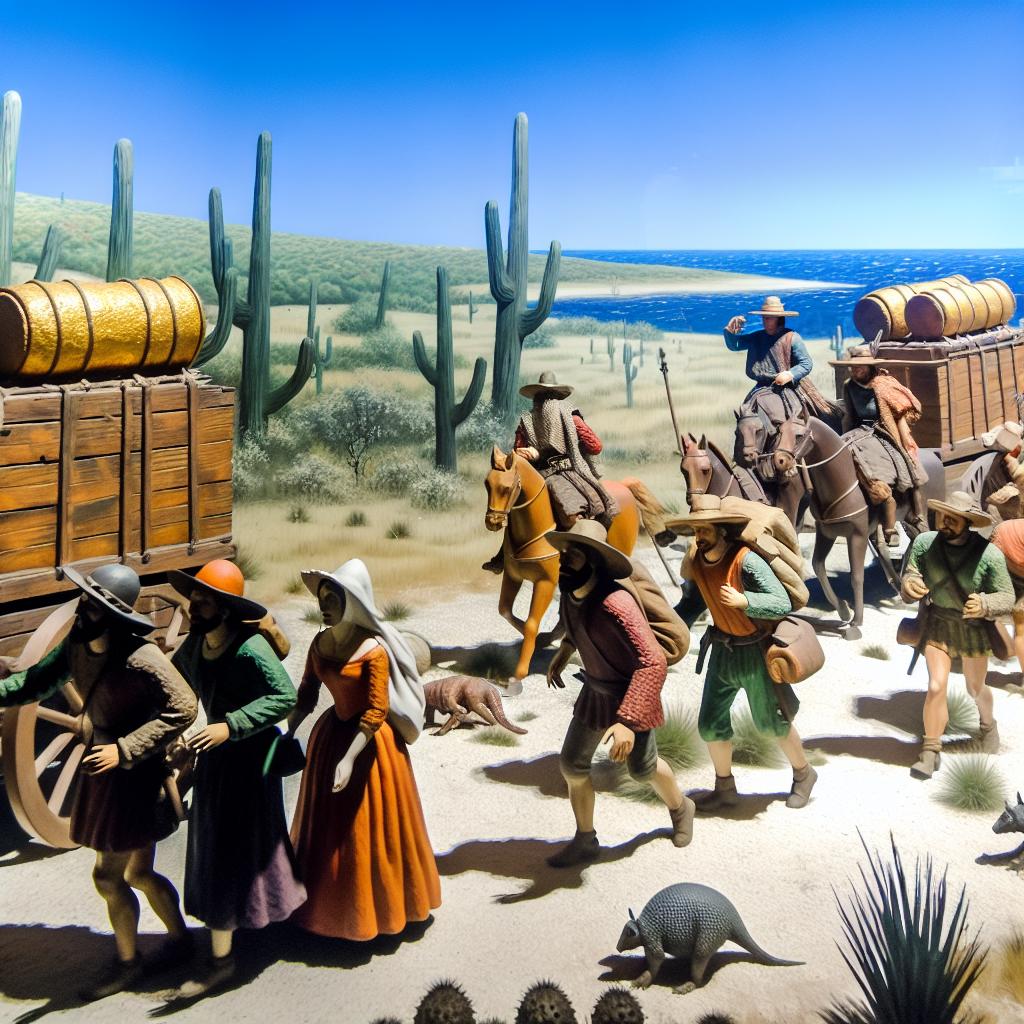Introduction to Spanish Expeditions in Texas
During the Age of Exploration, the Spanish Empire was a dominant force, driven by the allure of new lands and precious minerals. Among these endeavors were Spanish expeditions to present-day Texas, primarily motivated by the pursuit of gold. Although the Spanish did not find vast quantities of gold in Texas itself, their expeditions significantly impacted the region’s history and development.
The Early Expeditions
Spanish interest in Texas was sparked by earlier explorations in the Americas, where conquistadors discovered immense wealth, including the treasures of the Aztecs and Incas. Inspired by these successes, explorers like Álvar Núñez Cabeza de Vaca ventured into lands that would later be part of Texas. While de Vaca’s accounts suggested riches in the region, tangible gold discoveries in Texas were minimal.
The Legend of El Dorado
A significant motivating factor for these expeditions was the elusive legend of El Dorado, a mythical city of gold. Expeditions funded by the Spanish crown often set out with high hopes of striking riches. However, the narrative of abundant gold in Texas remained largely unfulfilled, with only isolated small findings that did not meet expectations.
Challenges of the Expeditions
The expeditions faced numerous challenges, including harsh terrains, unpredictable weather, and resistance from indigenous tribes. Supplies were often scarce, and the long journeys took a toll on both men and horses. Navigating through unknown and often hostile territories required significant foresight and the ability to adapt to constantly changing conditions.
Establishment of Missions and Settlements
Although the Spanish did not find significant gold in Texas, their expeditions led to important developments such as the establishment of missions and settlements. These served as both religious and economic centers. Here, Spanish missionaries and settlers engaged in agriculture and trade, laying the foundations for future growth in the region.
- The Role of the Missions: The missions played a critical role in imparting to the indigenous peoples not only religious beliefs but also agricultural techniques, crafts, and new technologies.
- Cultural Exchange: Over time, these interactions led to a blending of Spanish and indigenous customs, which can still be observed in the Texas culture today.
The Impact on Indigenous Populations
The arrival of Spanish explorers had profound effects on the indigenous peoples of Texas. The expeditions often led to cultural exchanges, sometimes peaceful and other times marked by conflict. The introduction of European goods, horses, and livestock significantly altered the way of life for many indigenous communities. The Spanish influence persisted long after the expeditions ended, especially through the spread of Christianity and European agricultural practices.
Adaptation and Resistance
While some indigenous groups adapted to the presence of the Europeans, incorporating new tools and animals into their daily lives, others resisted the changes imposed by the foreigners. Conflicts occasionally erupted, which sometimes resulted in violent confrontations. Despite these tensions, the lasting impact of these cultural exchanges is evident in various aspects of modern Texan culture.
The Introduction of Livestock and Agriculture
The Spanish introduction of livestock such as cattle, horses, and sheep, alongside European agricultural practices, transformed the landscape and economy of the region. Native grasslands were altered to make way for farming, and overgrazing by cattle led to environmental changes. This shift laid essential groundwork for the development of Texas’s agricultural sector, which remains a significant part of the state’s economy.
Legacy of the Spanish Expeditions
Despite the absence of significant gold discoveries, Spanish expeditions to Texas played a crucial role in shaping the region’s history. They paved the way for future European settlements and introduced new cultural and economic influences that are still evident today.
- Language and Religion: Spanish colonization left a linguistic and religious legacy, visible in Texas’s place names, the prevalence of Spanish as a second language, and the continued influence of Catholicism.
- Economic and Social Structures: The expeditions introduced economic systems that laid the groundwork for later development in ranching and farming, helping to establish Texas as a leading agricultural center.
Over time, the Spanish-built missions evolved into communities that contributed to the cultural and historical mosaic of Texas. This legacy is a testament to the Spanish expeditions’ long-term effects, beyond their initial quests for wealth.
Conclusion
The Spanish expeditions in Texas reflect the broader narrative of European exploration in the New World, characterized by a mix of ambition, conquest, and cultural interaction. While the quest for gold remained largely unfulfilled in Texas, the legacy of these expeditions is undeniable, leaving a lasting imprint on the region’s cultural and historical landscape. Their journey marked the beginning of profound changes, shaping not just the social and economic structures but also influencing cultural evolution across generations. For further reading on this topic, you may explore comprehensive histories from reliable sources such as academic publications and historical archives.


